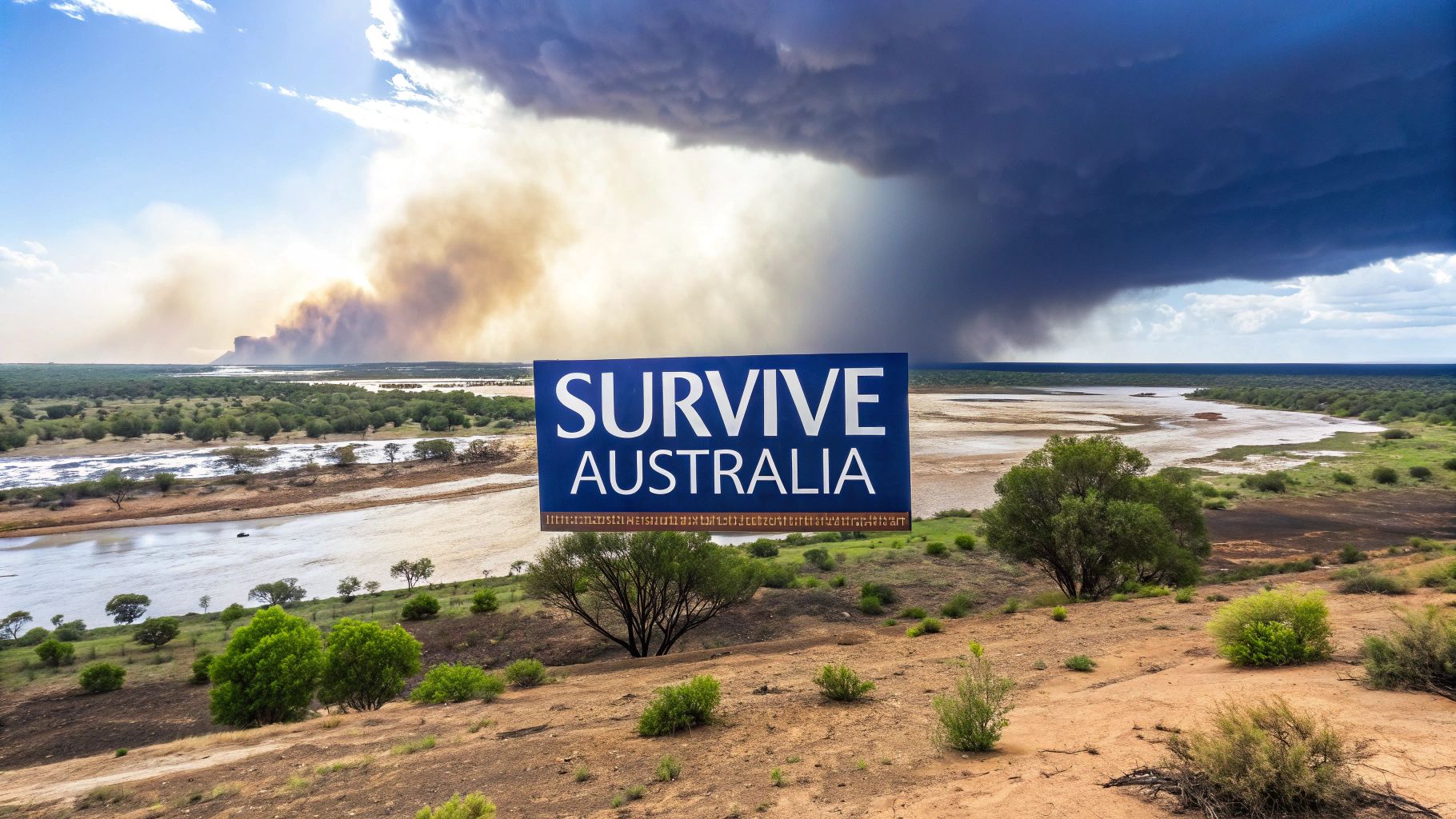For Texas-based leaders managing operations in Australia, the continent's rugged landscape presents a unique set of operational risks. The region is defined by powerful natural hazards, including intense bushfires, widespread floods, tropical cyclones, and severe droughts.
These are not isolated events but recurring features of the Australian climate, posing significant threats to infrastructure, supply chains, and workforce safety. For any company in the Energy, Manufacturing, Logistics, Agriculture, or Construction sectors, understanding and mitigating these risks is a critical component of strategic planning.
Understanding Australia's Unique Operational Risk Landscape
Australia's environment is one of extremes, where years of drought can be followed by record-breaking floods. This volatility directly impacts business operations, affecting water availability, transport logistics, and the physical integrity of facilities. The frequency and severity of these events are creating tangible, costly disruptions.
Data highlights a clear escalation in risk. In 2022, an estimated 70% of Australians—approximately 18 million people—lived in a local government area impacted by at least one natural disaster. This figure is more than double the average from the past decade, signaling an urgent need for robust risk management.
Mapping the Primary Threats to Business Operations
A generic disaster plan is insufficient for the Australian operational environment. Each primary hazard presents distinct challenges that require a tailored mitigation strategy:
- Bushfires: Threaten physical assets, sever power and communication lines, and generate hazardous smoke, forcing prolonged shutdowns of outdoor operations for industries like construction and energy.
- Floods: Damage buildings and destroy critical transport infrastructure like roads and railways, contaminate water supplies, and lead to long-term operational paralysis for logistics and manufacturing.
- Tropical Cyclones: Inflict catastrophic damage on coastal infrastructure, impacting the ports, energy terminals, and logistics hubs vital to Northern Australia's resource and agriculture sectors.
- Droughts & Heatwaves: Strain water resources essential for agriculture and industrial processes, reduce workforce productivity due to health and safety protocols, and increase the risk of equipment failure and fire.
Effective risk mitigation requires a strategy that directly addresses how each of these specific hazards could impact a company's unique operational footprint.
A clear view of corporate exposure is the first step. A structured framework is essential for mapping potential impacts. Decision-makers can learn more about leading industry methods in our guide to effective climate risk assessment tools. This guide will detail these core threats and outline practical, non-insurance-based strategies to safeguard Australian operations.
Australia's Primary Natural Hazards at a Glance
For executives managing assets from Texas, this table provides a high-level summary of Australia’s most common hazards, the regions they primarily affect, and their typical seasonality.
| Hazard Type | Primary Affected Regions | Typical Seasonality |
|---|---|---|
| Bushfires | Southeastern & Southwestern Australia | Summer (December-February) |
| Floods | Eastern Australia (QLD, NSW, VIC) | Varies; often Summer & Autumn |
| Tropical Cyclones | Northern Australia (WA, NT, QLD) | November - April |
| Droughts | Murray-Darling Basin, Eastern Australia | Can be multi-year events |
| Heatwaves | Southern & Central Australia | Summer (December-February) |
| Severe Storms | Eastern & Southeastern Australia | Spring & Summer (September-February) |
This table serves as a foundational reference. However, as weather patterns become less predictable, a location-specific risk assessment is essential for understanding true operational exposure.
Disclaimer: ClimateRiskNow does not sell insurance or financial products. The information provided is for educational purposes only and should not be interpreted as financial advice.
Australia’s Major Natural Hazards: An Operational Deep Dive
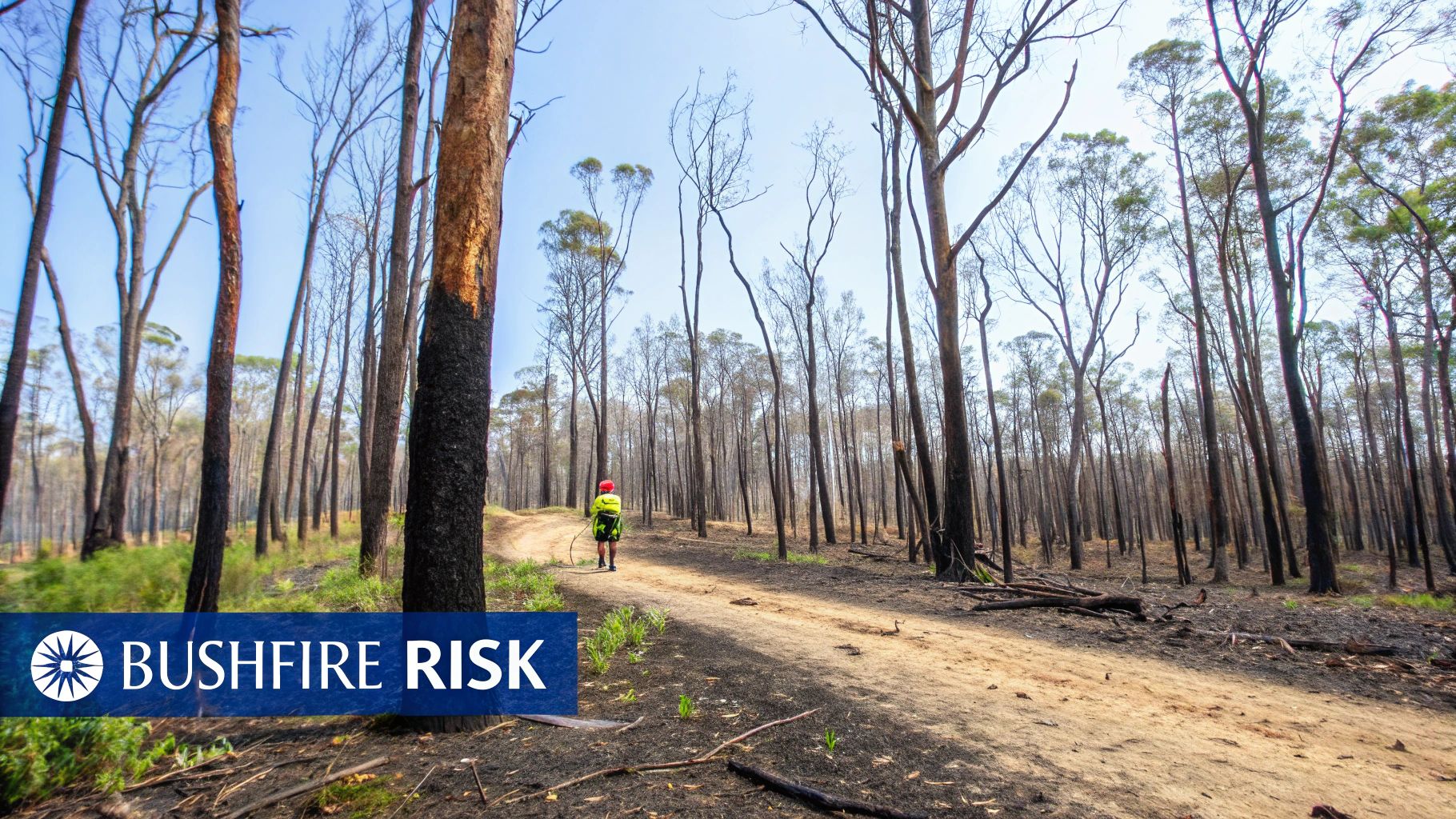
Effective risk management requires a deep understanding of the mechanics behind Australia's natural hazards. Each event, from a bushfire to a cyclone, introduces a different set of operational threats, demanding a specific response plan. This section breaks down the key drivers of the continent's major hazards and their direct impacts on assets, supply chains, and personnel.
The Science of Australian Bushfires
A bushfire requires three components: fuel, oxygen, and heat. Australia’s vast eucalyptus forests provide a continuous supply of highly flammable fuel containing volatile oils. Combined with the continent's hot, dry climate, the conditions for catastrophic fires are frequently met. For Texas-based energy or construction companies, this environmental factor is a direct threat to the bottom line.
The intense radiant heat from a fire front can warp steel and compromise the structural integrity of facilities. Smoke alone can be thick enough to halt all outdoor work, triggering costly project delays and grinding productivity to a halt.
Operational threats from bushfires extend beyond the fire itself:
- Infrastructure Damage: Fires destroy critical power lines, communication towers, and transport routes, isolating facilities and severing supply chains for weeks.
- Workforce Safety: Evacuation orders and hazardous air quality present significant health and safety challenges, impacting employee availability and well-being.
- Asset Destruction: Remote facilities, pipelines, and heavy machinery located in or near bushland are vulnerable to total loss.
The Drivers of Widespread Flooding
Much of Australia's flooding is influenced by large-scale climate drivers, primarily the El Niño-Southern Oscillation (ENSO) cycle. During a La Niña phase, warmer ocean waters in the western Pacific increase atmospheric moisture over eastern Australia, often leading to above-average rainfall and catastrophic flooding.
This cycle can transform entire regions into a logistical nightmare. For a manufacturing or logistics firm, a major flood means the paralysis of its distribution network as highways and rail lines become submerged.
The impact of flooding is rarely confined to a single site. It creates a cascade of disruptions that can cripple regional economies, affecting suppliers, customers, and employees simultaneously. Understanding these interconnected vulnerabilities is critical.
The consequences are severe. Between 2008 and 2023, approximately 240,828 people in Australia were displaced by extreme weather events, with flooding as a primary cause. The 2022 floods in New South Wales and Queensland became the country's costliest climate-driven disaster, with insured losses estimated at AUD 3.5 billion. A deeper analysis of the financial fallout is available in this parliamentary report.
For more detailed information, review our guide covering key facts about flooding.
Cyclones and Severe Storms
Tropical cyclones are powerful, rotating storm systems that form over the warm tropical waters north of Australia. They act as massive heat engines, converting ocean energy into hurricane-force winds, extreme rainfall, and destructive storm surges. These storms primarily threaten the northern coastlines of Western Australia, the Northern Territory, and Queensland.
For any business with coastal infrastructure—such as ports, LNG terminals, and agricultural processing plants—a direct hit from a cyclone can be catastrophic. A category 4 or 5 cyclone can level buildings, topple cranes, and mangle critical infrastructure, forcing a complete shutdown of regional operations and exports.
Droughts and Intense Heatwaves
Just as La Niña can bring floods, its counterpart, El Niño, often brings drought. This phase is characterized by cooler ocean temperatures in the western Pacific, which reduces the moisture supply and leads to prolonged dry spells across eastern Australia. For agriculture and water-reliant industries, the impact is immediate.
Heatwaves frequently accompany drought. Extended periods of extreme heat can cause equipment to overheat and fail, buckle railway lines, and strain the power grid. For construction and logistics crews, this means reduced working hours to comply with safety regulations, leading to significant productivity drops and project delays.
Disclaimer: ClimateRiskNow does not sell insurance or financial products. All information provided is for educational purposes only and should not be considered financial advice.
Learning From Australia's Most Impactful Disasters: Case Studies for Industry
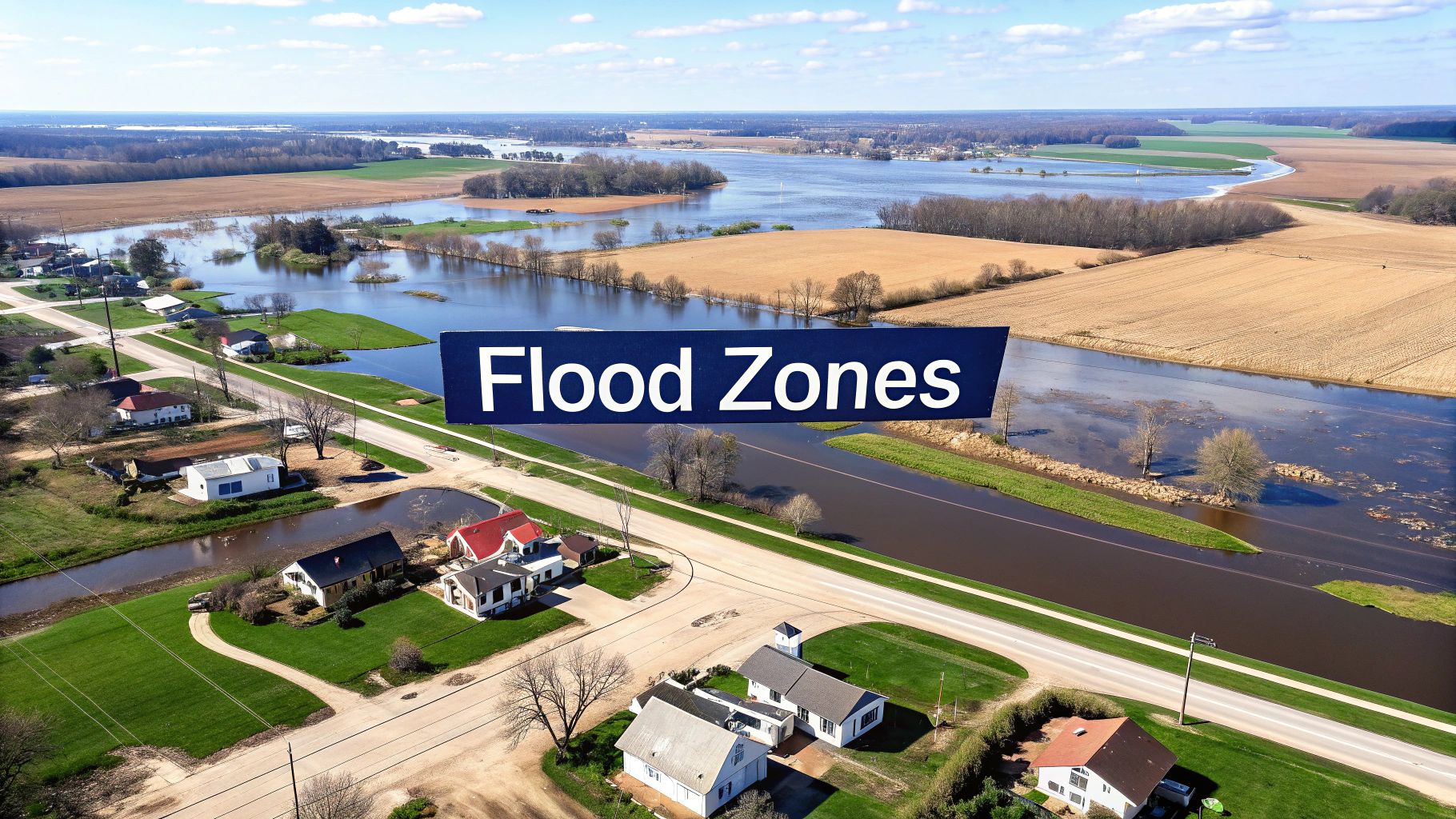
Understanding the theory behind Australia's natural hazards is one thing; witnessing their impact on business operations provides another level of insight. The most powerful lessons in risk management come from historical events, which offer an unfiltered look at how supply chains fail, infrastructure crumbles, and operations are pushed to their limits.
By analyzing past disasters, decision-makers can move beyond abstract models to a concrete understanding of what can go wrong. For Texas-based leaders with assets in Australia, these events are a masterclass in operational risk, exposing hidden dependencies and cascading failures that only emerge in a real crisis.
Case Study: The 2019-20 Black Summer Bushfires
The "Black Summer" of 2019-20 was an event of unprecedented scale that demonstrated how a single hazard can trigger a catastrophic domino effect across multiple industries.
For logistics and manufacturing sectors, the immediate impact was the shutdown of key transportation arteries. Major highways connecting vital economic hubs were closed for weeks, effectively severing supply chains. A shipment that normally took a day was delayed by a week or more.
This paralysis led to several critical business challenges:
- Inventory Gridlock: Companies could not receive raw materials or ship finished products, halting production lines and causing missed delivery deadlines.
- Workforce Disruption: Employees in affected areas were evacuated or unable to commute, creating significant staff shortages.
- Infrastructure Failure: The fires destroyed critical power and communications infrastructure, isolating entire facilities from corporate networks.
The Black Summer proved that a business does not need to be in a fire’s direct path to be impacted. Connection to a crippled supply chain or a downed power grid can be equally devastating.
Australia's history is filled with such events. The 2019-2020 Black Summer fires burned an estimated 117 million hectares, destroyed over 3,500 homes, and were directly responsible for at least 33 deaths. Decades earlier, Cyclone Tracy in 1974 flattened Darwin with 217 km/h wind gusts. You can explore more on Australia's most significant natural disasters to understand the full scope.
Case Study: The 2011 Queensland Floods
The 2011 Queensland floods offer a different but equally important lesson, focused on the state’s critical resource and agriculture sectors. When floodwaters inundated large areas of Central Queensland, they shut down one of the world's most important coking coal export chains.
The entire network, from mines to railways to the Port of Brisbane, was brought to a standstill. For energy and mining firms, this was a total operational shutdown with shockwaves that rippled through global markets.
This event highlighted two critical realities for decision-makers:
- Concentration Risk: The heavy dependence on a single rail corridor and port created a massive single point of failure. When that network failed, there was no alternative.
- Long Recovery Timelines: The problem was not resolved in days. It took months to dewater mines and repair rail lines, resulting in billions of dollars in lost revenue.
These operational lessons are not unique to Australia; they echo the challenges observed in Texas during Hurricane Harvey. To compare these situations, you can read our analysis on the lessons learned from Hurricane Harvey's impact. These case studies make it clear: risk management must account for regional infrastructure dependencies and the possibility of extended recovery periods.
Disclaimer: ClimateRiskNow does not sell insurance or financial products. The information provided is for educational purposes only and should not be interpreted as financial advice.
How to Assess Your Operational Risk in Australia
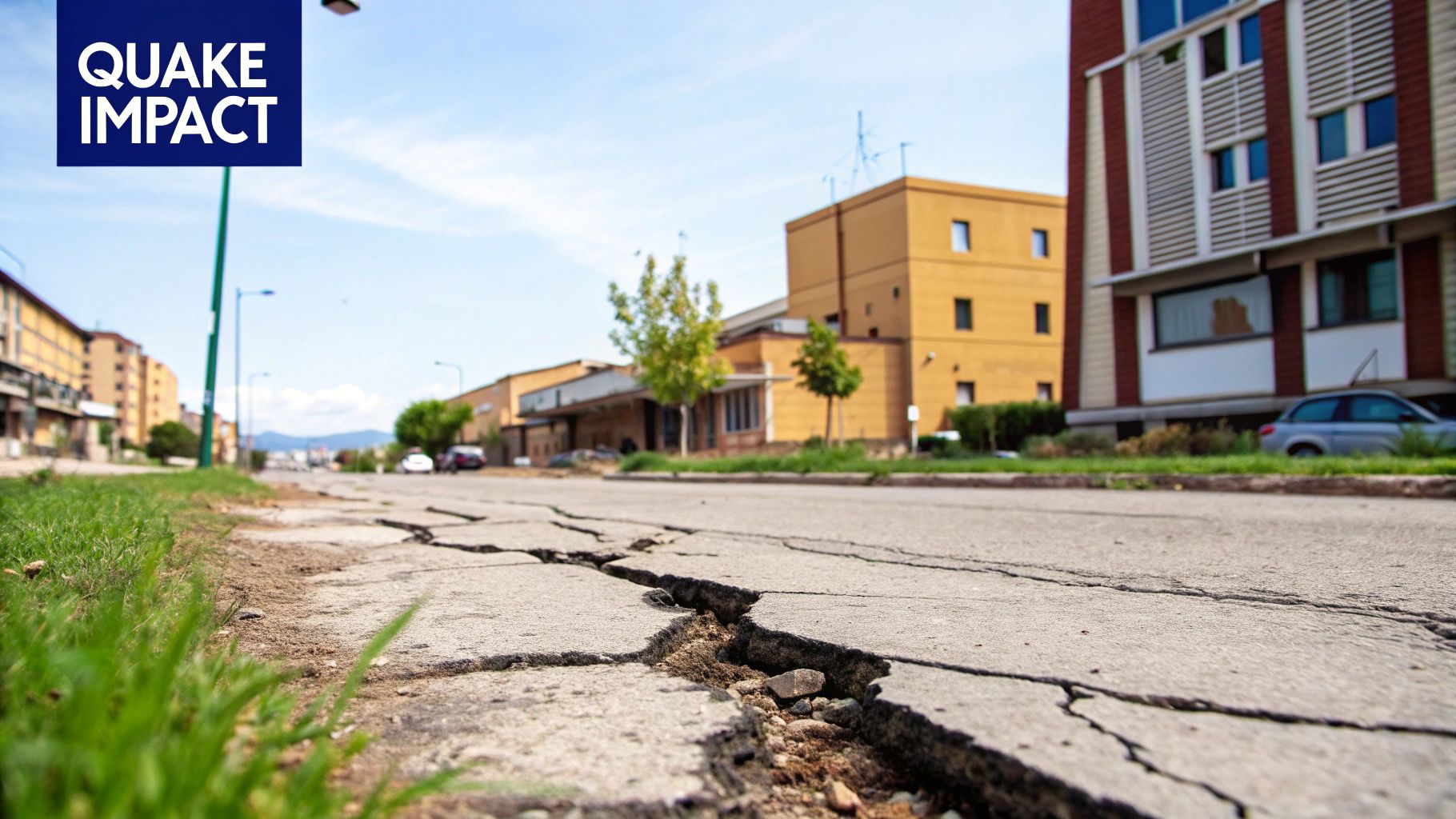
Knowledge of Australia's natural hazards becomes actionable only when applied directly to your company's operations. The next step is a rigorous "business stress test"—a systematic assessment to identify specific vulnerabilities before a disaster does.
This process involves asking targeted questions about assets, personnel, and processes to move from a high-level awareness of risk to a granular, site-by-site identification of operational weak points.
Identifying Site-Specific Vulnerabilities
Given Australia's diverse climate zones, a one-size-fits-all plan is ineffective. A facility in cyclone-prone Northern Queensland faces different threats than a manufacturing plant in the bushfire corridors of Victoria.
Begin by mapping every physical location against known hazard zones. This requires a detailed analysis of local topography and historical event data.
- Flood Exposure: Is your facility located in a designated floodplain? What is its proximity to rivers or coastal areas vulnerable to storm surge? A 1-in-100-year flood event is a plausible scenario that requires planning.
- Bushfire Risk: What is the vegetation surrounding your site? Is it in an area with a high Bushfire Attack Level (BAL) rating, a metric used in Australian building regulations?
- Cyclone and Storm Impact: Is your infrastructure constructed to meet or exceed the wind-loading standards for its region? How secure are port facilities against cyclonic winds?
A risk assessment must be grounded in the physical reality of each location. An asset's value is intrinsically tied to its ability to withstand the specific hazards of its environment.
Mapping Your Operational Dependencies
After assessing physical sites, the next step is to examine the connective tissue of your business. A disaster's impact often ripples through supply chains, logistics networks, and utility grids. This process uncovers hidden vulnerabilities that are frequently overlooked.
To begin, ask these critical questions:
- Supply Chain Chokepoints: Which key suppliers are located in high-risk zones? What are the single points of failure in your distribution network, such as a specific highway, port, or rail line?
- Utility and Infrastructure Reliance: How long can your facilities operate without grid power or municipal water? Do you have redundant communication systems?
- Workforce Accessibility: What percentage of your team lives in areas that could be isolated by floods or fire? Is there a remote work plan in place if a site becomes inaccessible?
Answering these questions provides a clear view of your operational fragility. For a deeper dive into structuring this evaluation, refer to our guide on various risk assessment methodologies. It offers frameworks to help build an internal stress test. This dual assessment—examining both site-specific and network-wide risks—is the cornerstone of building genuine resilience.
Disclaimer: ClimateRiskNow does not sell insurance or financial products. The information provided is for educational purposes only and should not be interpreted as financial advice.
Practical Strategies for Building Operational Resilience
Once operational weak points are mapped, the focus shifts to building defenses. This involves making smart, data-driven investments to strengthen the business from within. True resilience is achieved through proactive strategies designed to maintain operations when a natural hazard strikes.
The goal is to transition from a reactive mindset of post-disaster cleanup to a proactive one where mitigation is integrated into standard operating procedures. This includes fortifying physical assets, creating redundancy in critical supply lines, and equipping personnel with the tools to adapt under pressure.
Fortifying Physical Assets and Infrastructure
Your buildings and equipment are the first line of defense. Ensuring they can withstand local hazards is the most direct way to reduce potential damage and costly downtime. This begins with an assessment of current infrastructure against regional building codes and industry best practices.
For operations in cyclone-prone Northern Australia, this means exceeding minimum requirements by reinforcing roofing, securing large equipment, and shielding critical systems from extreme wind and water.
An investment in structural reinforcement is almost always more cost-effective than rebuilding and absorbing the lost revenue that accompanies it. Prioritize upgrades based on the highest-probability, highest-impact risks identified in your assessment.
Consider these targeted actions:
- For Bushfire Zones: Establish and maintain a vegetation clearance zone around facilities. Upgrade to fire-resistant building materials for roofing and external walls.
- For Floodplains: Elevate critical equipment, such as electrical panels and HVAC systems, above projected flood levels. Install flood barriers and improve site drainage.
- For Cyclone Regions: Strengthen structural connections and ensure all external fixtures are rated for high-wind loads. Conduct regular inspections of roofing and building exteriors.
Diversifying Supply Chains and Logistics
The supply chain is a classic point of failure during a disaster. The 2011 Queensland floods demonstrated how a single event could paralyze an entire industry by disabling one critical rail line. Reliance on a single supplier or transport route is a significant, often overlooked, vulnerability.
Building redundancy into your supply chain is a powerful mitigation strategy. This involves identifying and vetting alternative suppliers in different geographic regions to create a buffer against localized disruptions. It also requires mapping multiple transport routes and modes—road, rail, sea, and air—to ensure operational continuity.
The infographic below illustrates the scale of a single hazard like cyclones, highlighting why dependence on one coastal region is a high-risk strategy.
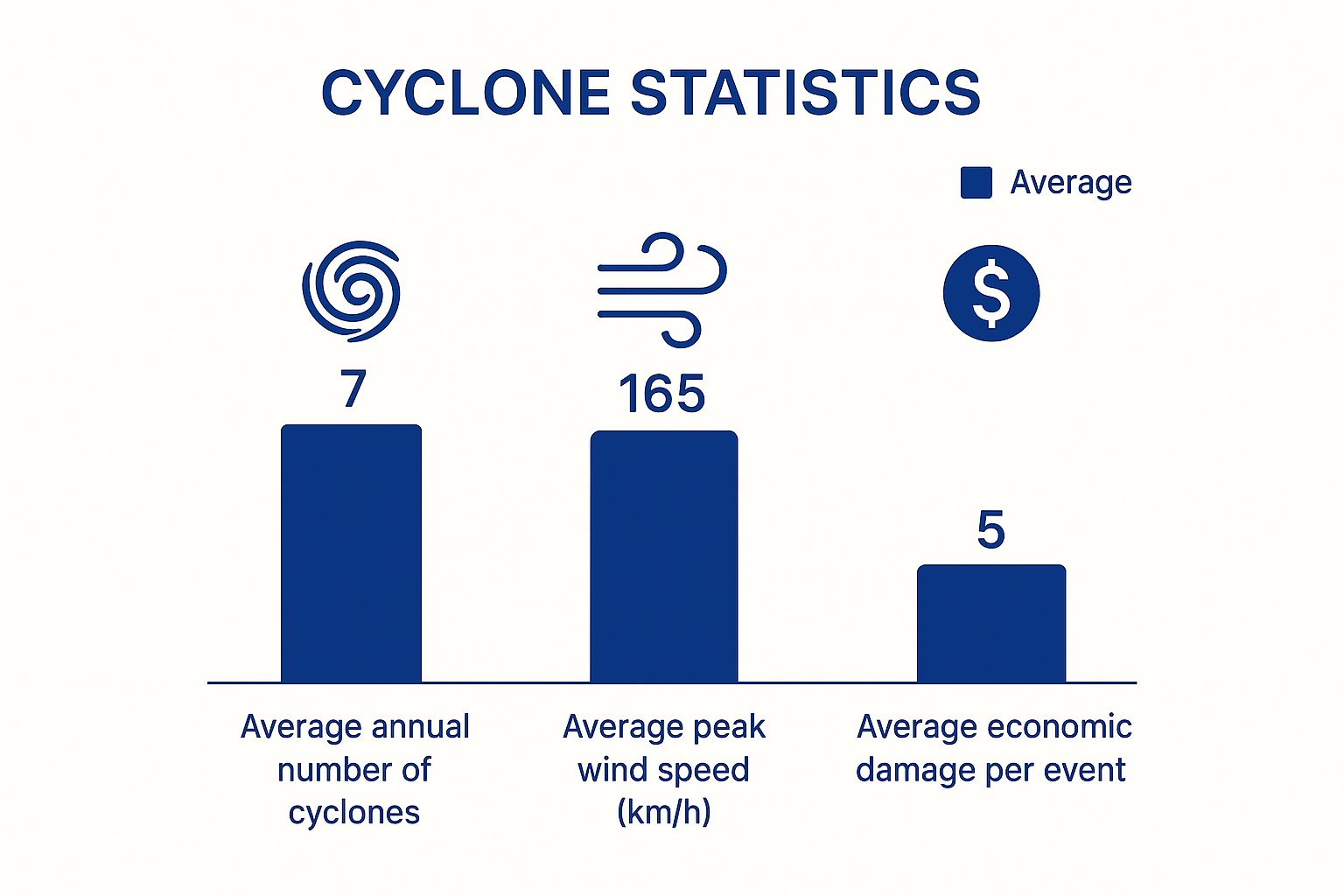
The data shows that cyclones are not only frequent but also powerful, bringing significant economic consequences that can cripple unprepared regional infrastructure.
Comparing Hazard Mitigation Strategies
Selecting the right mitigation strategy involves balancing the hazard against your business needs. This table provides a comparison to help frame your decision-making.
| Mitigation Strategy | Applicable Hazards | Primary Business Benefit | Implementation Considerations |
|---|---|---|---|
| Structural Reinforcement | Cyclones, Bushfires, Floods | Reduces physical damage, downtime, and repair costs. | High initial capital cost; requires engineering expertise. |
| Supply Chain Diversification | All Hazards | Ensures continuity of operations and materials flow. | Requires vetting new suppliers and logistics partners. |
| Remote Work Capability | All Hazards | Maintains core business functions when a site is inaccessible. | Needs robust IT infrastructure and secure network access. |
| Specialized Equipment Access | Floods, Storms | Speeds up site access, repair, and recovery efforts. | May involve rental agreements or capital investment. |
Each strategy plays a different role. The most resilient businesses often layer several of them to create a robust defense.
Enhancing Operational and Workforce Flexibility
Resilience extends beyond physical infrastructure to people and processes. When a site becomes inaccessible due to floods or a bushfire evacuation order, the ability to maintain core functions depends on operational flexibility.
Developing robust remote work protocols is a core component of business continuity. This means ensuring your team has the technology and secure network access needed to perform critical tasks from any location.
For businesses in flood-prone or marshy areas, awareness of available tools can be a game-changer. Knowledge of resources like specialized amphibious equipment can be crucial for site access, repairs, and recovery after a major flood.
A truly resilient organization is one that can adapt. For a more structured approach, see our guide on creating a business resilience framework.
Disclaimer: ClimateRiskNow does not sell insurance or financial products. The information provided in this article is for educational purposes only and should not be interpreted as financial advice.
Building a Resilient Future for Your Business
Operating in Australia necessitates managing natural hazards. However, significant operational disruption is not inevitable. By understanding the primary threats, learning from major events, and systematically identifying vulnerabilities, companies can build a robust defense.
The key takeaway is one of empowerment. For Texas-based leaders overseeing Australian operations, the first step is to view climate risk as a manageable business challenge. This perspective shift enables a move from reactive crisis management to proactive, strategic fortification of assets, supply chains, and personnel.
The goal is not to eliminate all risk, but to build an organization with the structural integrity and operational flexibility to withstand shocks, recover quickly, and maintain profitability—regardless of Australia's unique climate challenges.
Understanding available funding can be critical for post-disaster recovery. For businesses and their communities, resources like the EDA Disaster Supplemental Grants for economic resilience can provide vital support for rebuilding.
By using data-driven insights and a strategic approach to mitigation, companies can turn a significant liability into a competitive advantage. A proactive stance not only ensures operational survival but also positions the business for long-term success in a demanding environment.
Disclaimer: ClimateRiskNow does not sell insurance or financial products. The information provided is for educational purposes only and should not be interpreted as financial advice. Our goal is to equip decision-makers with the objective insights needed to build operational resilience.
Frequently Asked Questions for Business Leaders
When addressing the scale of Australia's natural hazards, business leaders often have questions that are foundational to building an effective operational strategy. Here are answers to common inquiries.
What is the Most Economically Damaging Natural Hazard in Australia?
Historically, floods and bushfires have caused the most significant economic damage. The 2022 floods across New South Wales and Queensland became the costliest climate-driven disaster in the country's history. These events damage critical infrastructure, disrupt supply chains, and can bring entire industries to a standstill, resulting in billions in direct losses and long-term recovery costs.
How Should a Company with Operations Across Australia Begin a Risk Assessment?
The crucial first step is to conduct a multi-hazard risk assessment for each operational site. A uniform approach is not effective. This involves analyzing historical data and climate projections to identify the specific threats—such as bushfire, flood, or cyclone—relevant to each location. Following this, map your critical supply chains to understand how a disaster in one region could create cascading failures throughout your network. This analysis allows you to allocate resources where they will have the greatest impact.
Are There Regulatory Requirements for Hazard Preparedness in Australia?
Yes, various state and local regulations must be considered. These often include specific building codes for sites in cyclone or bushfire-prone areas. Additionally, Workplace Health and Safety (WHS) legislation imposes a duty of care to protect employees during extreme weather events. Environmental regulations regarding water management and land use in floodplains are also common. Adherence to local and state government requirements is a fundamental part of effective risk management.
Please note that this information is for educational purposes only. ClimateRiskNow does not sell insurance or financial products and this content should not be interpreted as financial advice.
At ClimateRiskNow, we provide actionable, location-specific weather risk intelligence to help Texas-based businesses protect their operations in challenging environments like Australia. Our assessments quantify your exposure to critical threats, enabling you to build a truly resilient enterprise.

